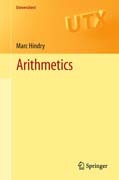
Number theory is a branch of mathematics which draws its vitality from a richhistorical background. It is also traditionally nourished through interactions with other areas of research, such as algebra, algebraic geometry, topology,complex analysis and harmonic analysis. More recently, it has made a spectacular appearance in the field of theoretical computer science and in questions of communication, cryptography and error-correcting codes. Providing an elementary introduction to the central topics in number theory, this book spans multiple areas of research. The first part corresponds to an advanced undergraduatecourse. All of the statements given in this part are of course accompanied bytheir proofs, with perhaps the exception of some results appearing at the endof the chapters. A copious list of exercises, of varying difficulty, are alsoincluded here. The second part is of a higher level and is relevant for the first year of graduate school. It contains an introduction to elliptic curves and a chapter entitled “Developments and Open Problems”, which introduces and brings together various themes oriented toward ongoing mathematical research. Given the multifaceted nature of number theory, the primary aims of this book are to: - provide an overview of the various forms of mathematics useful for studying numbers - demonstrate the necessity of deep and classical themes such as Gauss sums - highlight the role that arithmetic plays in modern applied mathematics - include recent proofs such as the polynomial primality algorithm - approach subjects of contemporary research such as elliptic curves - illustratethe beauty of arithmetic The prerequisites for this text are undergraduate level algebra and a little topology of Rn. It will be of use to undergraduates, graduates and phd students, and may also appeal to professional mathematiciansas a reference text. Explores the multi-faceted nature of number theory, spanning several areas of research in one text. Begins at undergraduate level and takes the reader through to graduate level. Includes recent proofs, such as the polynomial primality algorithm. INDICE: Finite Structures. Applications: Algorithms, Primality and Factorization, Codes. Algebra and Diophantine Equations. Analytic Number Theory. Elliptic Curves. Developments and Open Problems. Factorization. Elementary Projective Geometry. Galois Theory.
- ISBN: 978-1-4471-2130-5
- Editorial: Springer London
- Encuadernacion: Rústica
- Páginas: 322
- Fecha Publicación: 30/09/2011
- Nº Volúmenes: 1
- Idioma: Inglés
